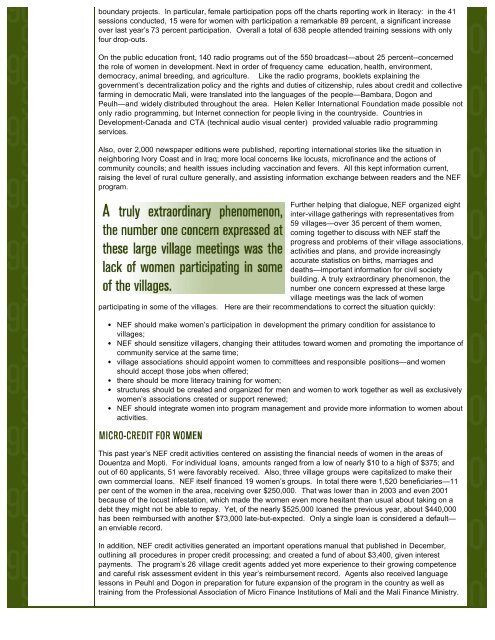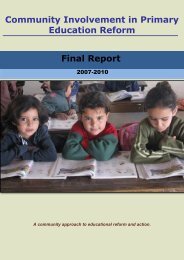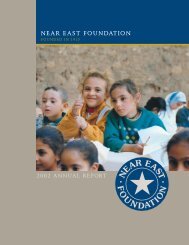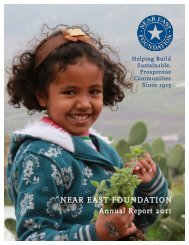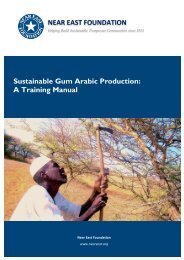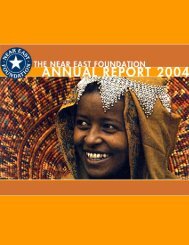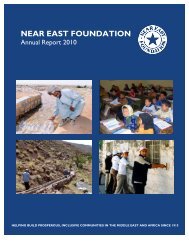NEF 2005 Annual Report - Near East Foundation
NEF 2005 Annual Report - Near East Foundation
NEF 2005 Annual Report - Near East Foundation
You also want an ePaper? Increase the reach of your titles
YUMPU automatically turns print PDFs into web optimized ePapers that Google loves.
oundary projects. In particular, female participation pops off the charts reporting work in literacy: in the 41<br />
sessions conducted, 15 were for women with participation a remarkable 89 percent, a significant increase<br />
over last year’s 73 percent participation. Overall a total of 638 people attended training sessions with only<br />
four drop-outs.<br />
On the public education front, 140 radio programs out of the 550 broadcast—about 25 percent--concerned<br />
the role of women in development. Next in order of frequency came education, health, environment,<br />
democracy, animal breeding, and agriculture. Like the radio programs, booklets explaining the<br />
government’s decentralization policy and the rights and duties of citizenship, rules about credit and collective<br />
farming in democratic Mali, were translated into the languages of the people—Bambara, Dogon and<br />
Peulh—and widely distributed throughout the area. Helen Keller International <strong>Foundation</strong> made possible not<br />
only radio programming, but Internet connection for people living in the countryside. Countries in<br />
Development-Canada and CTA (technical audio visual center) provided valuable radio programming<br />
services.<br />
Also, over 2,000 newspaper editions were published, reporting international stories like the situation in<br />
neighboring Ivory Coast and in Iraq; more local concerns like locusts, microfinance and the actions of<br />
community councils; and health issues including vaccination and fevers. All this kept information current,<br />
raising the level of rural culture generally, and assisting information exchange between readers and the <strong>NEF</strong><br />
program.<br />
Further helping that dialogue, <strong>NEF</strong> organized eight<br />
inter-village gatherings with representatives from<br />
59 villages—over 35 percent of them women,<br />
coming together to discuss with <strong>NEF</strong> staff the<br />
progress and problems of their village associations,<br />
activities and plans, and provide increasingly<br />
accurate statistics on births, marriages and<br />
deaths—important information for civil society<br />
building. A truly extraordinary phenomenon, the<br />
number one concern expressed at these large<br />
village meetings was the lack of women<br />
participating in some of the villages. Here are their recommendations to correct the situation quickly:<br />
<strong>NEF</strong> should make women’s participation in development the primary condition for assistance to<br />
villages;<br />
<strong>NEF</strong> should sensitize villagers, changing their attitudes toward women and promoting the importance of<br />
community service at the same time;<br />
village associations should appoint women to committees and responsible positions—and women<br />
should accept those jobs when offered;<br />
there should be more literacy training for women;<br />
structures should be created and organized for men and women to work together as well as exclusively<br />
women’s associations created or support renewed;<br />
<strong>NEF</strong> should integrate women into program management and provide more information to women about<br />
activities.<br />
This past year’s <strong>NEF</strong> credit activities centered on assisting the financial needs of women in the areas of<br />
Douentza and Mopti. For individual loans, amounts ranged from a low of nearly $10 to a high of $375; and<br />
out of 60 applicants, 51 were favorably received. Also, three village groups were capitalized to make their<br />
own commercial loans. <strong>NEF</strong> itself financed 19 women’s groups. In total there were 1,520 beneficiaries—11<br />
per cent of the women in the area, receiving over $250,000. That was lower than in 2003 and even 2001<br />
because of the locust infestation, which made the women even more hesitant than usual about taking on a<br />
debt they might not be able to repay. Yet, of the nearly $525,000 loaned the previous year, about $440,000<br />
has been reimbursed with another $73,000 late-but-expected. Only a single loan is considered a default—<br />
an enviable record.<br />
In addition, <strong>NEF</strong> credit activities generated an important operations manual that published in December,<br />
outlining all procedures in proper credit processing; and created a fund of about $3,400, given interest<br />
payments. The program’s 26 village credit agents added yet more experience to their growing competence<br />
and careful risk assessment evident in this year’s reimbursement record. Agents also received language<br />
lessons in Peuhl and Dogon in preparation for future expansion of the program in the country as well as<br />
training from the Professional Association of Micro Finance Institutions of Mali and the Mali Finance Ministry.


